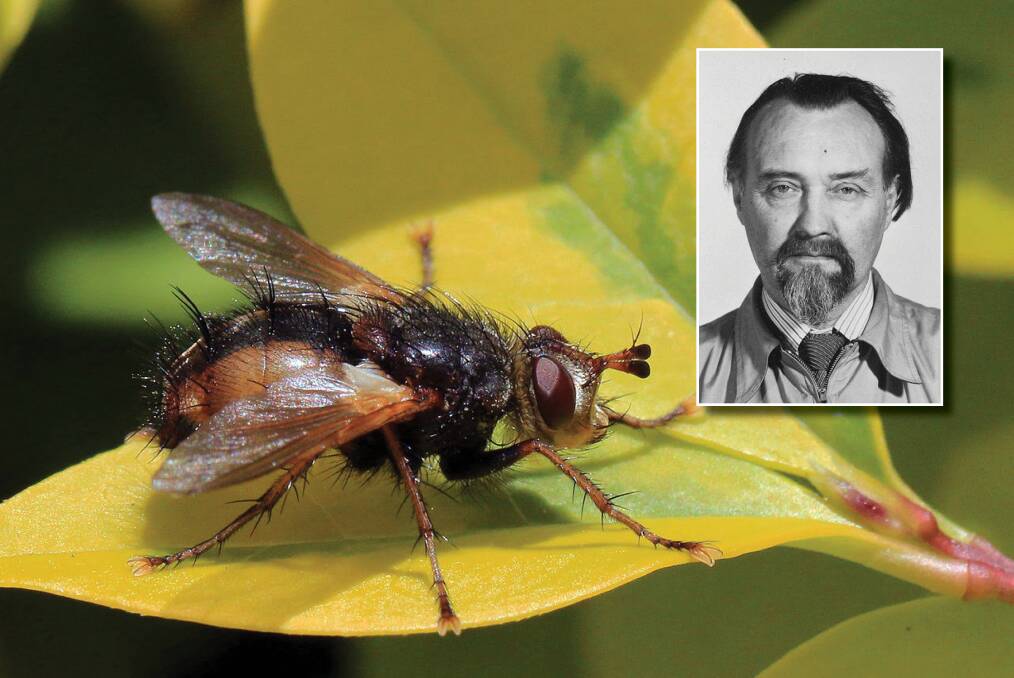
Australia was fortunate to obtain the services of one of the world's leading fly experts from January 1947. If you still are bothered by flies in summer, you'll understand why this was important.
Subscribe now for unlimited access.
$0/
(min cost $0)
or signup to continue reading
The dipterist, or fly specialist, was Sergey Paramonov, born in Kharkiv in 1894. By the time he died in Canberra in 1967, he had published 185 scientific papers about flies.
He personally had studied and named more than 1100 new fly species. That's an estimate, because the list occupies more than 11 pages of an entomology journal article, and it's known now that some accidentally included were identified by his younger brother in the United Kingdom.
Australia's luck in acquiring this world-famous scientist was due to him being stranded in Paris without paid employment after World War II. His war had been harrowing, particularly because of his devotion to duty as head of the Zoological Museum of Ukrainian Academy of Sciences from 1940.
The Museum was in Kyiv, invaded by the Germans during the war. Basements were mined and buildings bombed, much as in the current war. In 1943, various museum collections and their staff were transferred to Poznan in German-occupied Poland.
As the Soviet Army advanced towards Poznan in early 1945, the curators and collections moved to the Berlin area. There, Paramonov was arrested by some Germans who wanted to shoot him. Fortunately for Australia, and the study of flies, he was saved by a passing professor who knew him.
From that incident, Paramonov was able to get himself to Paris. There he started writing letters to scientists in the West, asking if they could help him find employment. One of them asked the head of the then CSIR if Australia was interested. The CSIR had been without an insect taxonomist since 1940, so it was very interested.
CSIRO colleagues became friends, but Sergey had left family behind.
His father had been arrested in 1938 on counter-revolutionary charges and executed. His mother had moved to Kyiv, where her late husband's alleged behaviour was not known. Sergey had been married to the widow of his university supervisor, who had died during the upheavals of 1919. Natalia had not been able to leave Kyiv with him.
Sergey had time on his hands so he turned to another interest, the early history of Slavic peoples, especially the Ukrainians and Russians.
When Sergey began this second stream of his career, he returned to his origins as the son of a forester to choose the pen name "Sergey Lesnoy". The adopted family name is a Russian word for the adjective "forest".
The name first appeared in print in 1945, while Paramonov was still in Paris. Music lovers will know Borodin's Prince Igor opera. It's an adaptation of The Tale of Igor's Campaign, an epic poem known to date from the late 1100s. The first Lesnoy article was a naturalist's perspective on The Tale of Igor's Campaign in a Russian-language emigrant magazine.
Four volumes of scientific analyses of the available literature on Prince Igor were published during 1950-53. Ten more books between 1953-60 discussed the history of Rus' people.
Despite Paramonov's scholarship, there is still much dispute over the origin of the Rus' or Ruthenians. They ruled a large area around Novgorod, in modern Russia, 500 to more than 1000 years ago.
He wrote four more books on this topic, published between 1956 and 1967. But another problem occupied his mind too.
Birch planks carved in an ancient language were supposed to have been found in 1919 near Kharkiv. They were lost during World War II. Some texts from these birch planks had been copied. Paramonov obtained all the available information from around the world, including a photograph.
As the photographed writing was interpreted to start with, literally, "Vles the book this'", Paramonov called the materials The Book of Vles (also Wles or Veles). The writing is still called by the name Paramonov gave to it. He wrote articles on it for Ukrainian- and Russian-language magazines and published his own book about the planks.
Veles is an ancient Slavic god of earth, waters, livestock, and the underworld. The Book of Veles has been set as a school text in Ukraine but Russian linguists believe it to be a forgery.
Thanks to the publicity from Lesnoy or Paramonov, The Book became a basis for modern Slavic paganism. Paramonov was a practising Christian though, a member of the Ukrainian Orthodox congregation in Turner. After his death in the Canberra Hospital in September 1967, he was buried in the Woden Cemetery. His estate was bequeathed to our local Ukrainian Orthodox community.
Paramonov has been remembered for posterity by his scientific colleagues in the names of three genera of flies, which together contain 23 species, plus another 26 species in other genera and two subspecies.
The Canberra Times joined in international excitement about the latest naming, in 2019. A CSIRO scientist had named a new fly Paramonovius nightking, after a Game of Thrones character. It's the only species in the Paramonovius genus, again honouring an important Canberran and Ukrainian more than 50 years after his death.
- Ann Tundern-Smith is a councillor of the Canberra & District Historical Society and editor of its Canberra History News.

